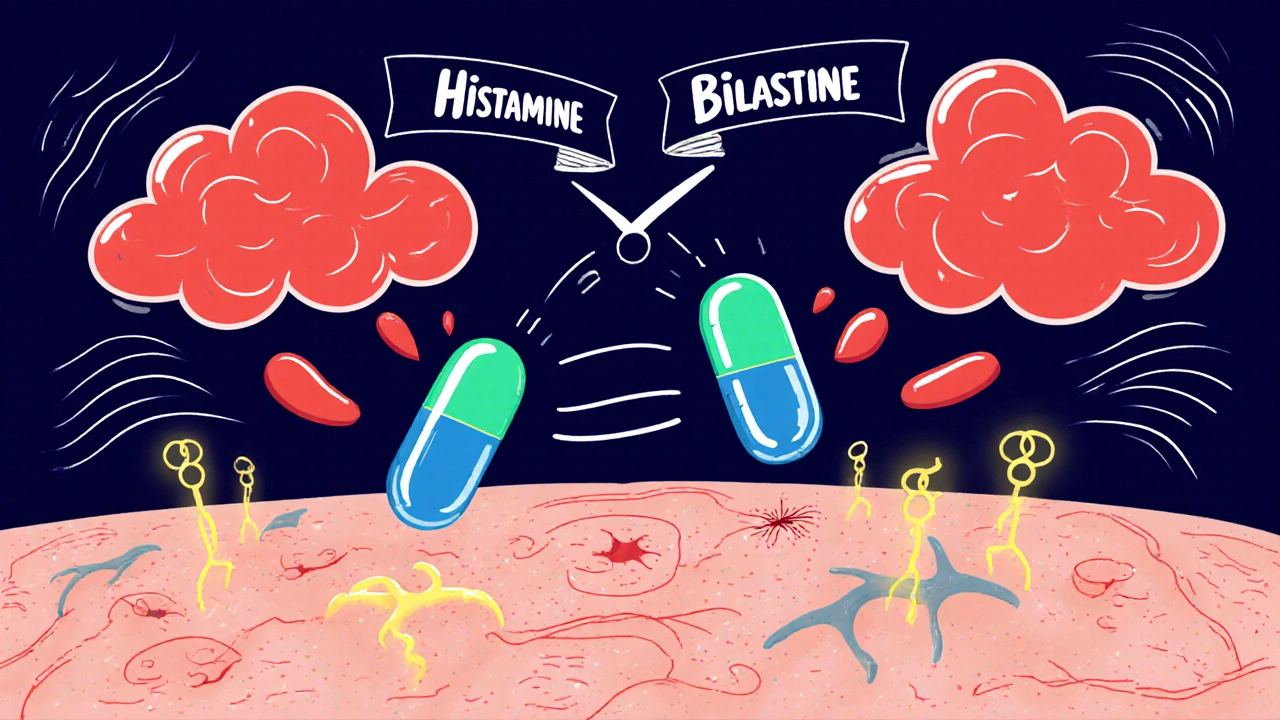When a 34‑year‑old Melbourne resident walked into a dermatology clinic plagued by daily hive outbreaks, her story seemed all too familiar for chronic urticaria sufferers. Years of itching, swelling, and sleepless nights had left her skeptical of every new prescription. Then her doctor prescribed a newer, non‑sedating antihistamine-Bilastine is a second‑generation H1‑receptor antagonist that blocks histamine without crossing the blood‑brain barrier. The results were dramatic, and the journey offers a practical blueprint for anyone battling stubborn hives.
Understanding Chronic Hives (Chronic Urticaria)
Chronic urticaria, commonly called chronic hives, is defined as the appearance of itchy wheals on the skin for six weeks or longer. Studies show that about 1% of the global population experiences this condition, with a higher prevalence among women aged 20‑45. The mechanism involves mast cells releasing histamine and other inflammatory mediators in response to triggers such as IgE antibodies, physical pressure, or even stress. The histamine then binds to H1 receptors on skin nerves, causing vasodilation, edema, and that dreaded itching sensation.
Why Bilastine Stands Out Among Antihistamines
First‑generation antihistamines like diphenhydramine are effective but often cause drowsiness because they penetrate the central nervous system. Second‑generation drugs, including cetirizine, fexofenadine, and levocetirizine, were developed to avoid that side effect. Bilastine, approved in the European Union in 2010 and later by the Australian Therapeutic Goods Administration (TGA) in 2021, offers several advantages:
- High affinity for the H1 receptor with minimal brain penetration.
- No need for dose adjustments in patients with mild to moderate renal impairment.
- Low potential for drug‑drug interactions because it is not metabolized by CYP450 enzymes.
These traits make it a prime candidate for long‑term management of chronic urticaria, especially for patients who need to stay alert at work or while driving.
The Patient Journey: From Frustration to Relief
bilastine became the turning point for our case study patient, Anna (name changed for privacy). Below is a timeline of her treatment:
- Initial presentation: Daily hives lasting 4‑6 hours, intense itching, and occasional facial swelling. Previous attempts with cetirizine 10 mg and fexofenadine 180 mg yielded partial relief but caused mild sedation.
- Diagnostic work‑up: Blood tests ruled out thyroid disorder and autoimmune disease. Skin prick testing identified a mild dust‑mite sensitivity, but the chronic nature suggested an autoimmune component.
- Bilastine initiation: 20 mg once daily, taken with water one hour before a meal (food can reduce absorption).
- First two weeks: Frequency of wheals dropped from an average of 8 per day to 2‑3, with itching severity decreasing from 8/10 to 3/10 on a visual analogue scale.
- One‑month follow‑up: No hives reported for five consecutive days; sleep quality improved dramatically. Minor side effects-dry mouth and mild headache-resolved within three days.
- Three‑month assessment: Complete remission of visible hives, maintained on the same dosage. The dermatologist recommended continuation for six months to ensure stability.
Anna’s story underscores that while individual responses vary, Bilastine can deliver rapid and sustained control for many chronic urticaria patients.

How Bilastine Works: A Simple Pharmacology Snapshot
The drug binds competitively to peripheral H1 receptors, preventing histamine from triggering the cascade that leads to edema and itch. Because it does not significantly cross the blood‑brain barrier, central H1 receptors remain unblocked, sparing the patient from sedation. Its bioavailability is around 60% when taken on an empty stomach, and the half‑life is roughly 14 hours, supporting once‑daily dosing.
Comparing Bilastine with Other Second‑Generation Antihistamines
| Attribute | Bilastine | Cetirizine | Fexofenadine |
|---|---|---|---|
| Typical adult dose | 20 mg once daily | 10 mg once daily | 180 mg once daily |
| Onset of relief | Within 1 hour | Within 1‑2 hours | Within 2‑3 hours |
| Sedation risk | None reported | Low‑moderate (up to 10% of users) | Very low |
| Food interaction | Reduced absorption with high‑fat meals | Minimal effect | None significant |
| Metabolism pathway | Not CYP450 dependent | Metabolised by CYP3A4 | Metabolised by CYP3A4 |
| Approved for chronic urticaria | Yes (EU, Asia, Australia) | Yes | Yes |
The table highlights why clinicians might favor Bilastine for patients who are sensitive to drug interactions or need a non‑sedating option.
Practical Checklist for Patients Starting Bilastine
- Timing: Take on an empty stomach or at least one hour before meals.
- Dosage adherence: Do not exceed 20 mg per day without medical supervision.
- Monitor side effects: Report persistent headache, dry mouth, or gastrointestinal upset.
- Follow‑up: Schedule a dermatologist visit after four weeks to assess efficacy.
- Pregnancy & lactation: Discuss with your doctor; current data are limited but suggest safety in the third trimester.
Common Pitfalls and How to Avoid Them
Even effective drugs can fall short if used incorrectly. Here are a few mistakes patients often make and the simple fixes:
- Skipping doses: Missing a day can trigger a flare‑up. Set a daily alarm.
- Taking with a high‑fat meal: Fat can cut absorption by up to 30%. Keep a light snack if needed.
- Combining with alcohol: While Bilastine itself isn’t sedating, alcohol can amplify any mild drowsiness. Limit intake.
- Self‑adjusting dose: Doubling the dose without guidance increases risk of side effects without guaranteeing better control.
Future Directions: What’s Next for Antihistamine Therapy?
Research is exploring dual‑action molecules that combine H1 antagonism with mast‑cell stabilisation. Meanwhile, biologics like omalizumab are reserved for antihistamine‑refractory chronic urticaria. Bilastine’s low interaction profile positions it as a solid backbone therapy while clinicians await more personalized options.
Frequently Asked Questions
Can I use Bilastine if I have liver disease?
Bilastine is primarily excreted unchanged in the urine; mild to moderate liver impairment does not require dose adjustment, but severe disease should be discussed with a physician.
How long does it take to see improvement?
Most patients notice reduced itching within 1‑2 hours of the first dose, with marked decrease in wheal frequency after 7‑10 days of daily use.
Is Bilastine safe for children?
In the EU, Bilastine is approved for children aged 6 years and older at a weight‑adjusted dose of 10 mg once daily. Always consult a pediatrician before starting.
Can I take Bilastine with other allergy meds?
Because Bilastine does not rely on CYP450 metabolism, it can be combined with leukotriene receptor antagonists or nasal corticosteroids without major interactions.
What should I do if I miss a dose?
Take the missed dose as soon as you remember unless it’s close to the next scheduled dose; in that case, skip the missed one and resume your regular schedule.
Whether you’re a patient seeking relief or a clinician evaluating options, Bilastine’s profile makes it a compelling choice for chronic urticaria. Armed with the right dosing strategy and a few practical tips, you can move from endless itching to a calmer, more comfortable daily life.

Lisa Woodcock
Wow, Anna’s experience really hits home for anyone who’s spent nights tossing and turning because of relentless hives. The way Bilastine cleared her symptoms in just a couple of weeks shows how important the right antihistamine can be. I’ve seen a few patients in my clinic who switched from cetirizine to Bilastine and finally got some decent sleep. If you’re struggling with daily flare‑ups, giving Bilastine a try under a doctor’s guidance could be a game‑changer.
Sarah Keller
Listening to Lisa’s take, I’m reminded that the pharmacodynamics of Bilastine are not just a footnote in a drug label but a decisive factor in patient quality of life; its high H1 affinity coupled with negligible CNS penetration directly translates to uninterrupted cognition during work or study. The fact that it’s not metabolised by CYP450 enzymes eliminates a whole class of drug‑drug interactions that often plague poly‑pharmacy patients, especially those managing comorbid conditions like hypertension or depression. Moreover, the rapid onset-often within an hour-means that patients don’t have to endure prolonged itching before noticing relief, which can otherwise exacerbate stress‑induced mast‑cell activation. The case study underscores that a once‑daily 20 mg dose maintains therapeutic plasma levels for the entire 24‑hour cycle, reducing the temptation to double‑dose when a flare occurs. From a systemic perspective, the lack of significant renal adjustment requirements simplifies prescribing for a broader demographic, including the elderly with mild renal decline. Importantly, the low sedation profile preserves driving safety, a non‑negotiable for many professionals who can’t afford a drowsy afternoon slump. The data also suggest that Bilastine’s reduced food effect-if taken on an empty stomach-optimises absorption, a nuance that clinicians need to emphasise during patient education. While the literature highlights its efficacy, the real‑world anecdotes, like Anna’s, provide the compelling narrative that drives adherence. In contrast, first‑generation antihistamines still dominate the over‑the‑counter market, but their anticholinergic burden can impair cognition and increase fall risk, especially in older adults. The table comparing Bilastine to cetirizine and fexofenadine makes it clear that while all three achieve H1 blockade, Bilastine edges out in interaction safety and central nervous system neutrality. For patients who have tried multiple agents with partial relief, the switch to Bilastine can feel like moving from a leaky faucet to a fully sealed pipe. The consistent remission reported at three months validates the drug’s role as a backbone therapy rather than a temporary fix. Healthcare providers should incorporate the practical checklist-empty‑stomach dosing, adherence monitoring, and follow‑up visits-to maximise outcomes. Finally, as the field inches toward biologics for refractory cases, having a solid antihistamine foundation like Bilastine could reduce the need for those more invasive, costly options.
Veronica Appleton
I’ve been on Bilastine for a month now and the itching is almost gone I take it with water before meals and it’s super easy to remember the once daily schedule
Melanie Vargas
That’s awesome 🎉 staying consistent is the secret sauce especially when you pair it with a light snack or just water 👍 keep it up!
Deborah Galloway
Honestly, I was skeptical at first because I’ve tried so many antihistamines and still woke up with hives. After reading the case study I asked my dermatologist about Bilastine and within ten days my skin felt calm. It’s been a relief to not have that constant itch driving me crazy.
Charlie Stillwell
While your anecdotal success is noted the larger pharmacokinetic profile merits scrutiny-Bilastine’s negligible CNS penetration offers a distinct advantage over first‑gen agents, yet we must remain vigilant about off‑label dosing practices 🙄 over‑reliance on single‑case narratives can skew real‑world efficacy assessments 🚀
Ken Dany Poquiz Bocanegra
Short and sweet: If you’re on multiple meds, Bilastine’s low interaction risk makes it a safe pick.
Amber Lintner
Who needs another antihistamine when lifestyle changes could be the real hero? Cutting down on stress, avoiding high‑fat meals, and establishing a bedtime routine might just eclipse any drug’s impact-don’t let pharma hype drown out common sense.
Lennox Anoff
While the romanticisation of “lifestyle cures” is appealing, it disregards the substantial immunopathology underpinning chronic urticaria; evidence demonstrates that mast‑cell degranulation can persist despite optimal sleep hygiene, and without H1 blockade the downstream edema cascade remains unchecked. Hence, the assertion that dietary or stress modifications alone can fully supplant pharmacotherapy oversimplifies a multifactorial disease process, rendering the argument both naive and potentially hazardous to patients seeking relief.